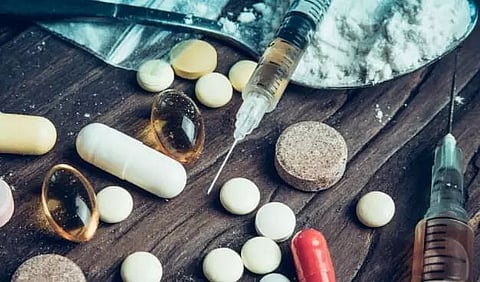
- Home
- Live Blog
- Breaking News
- Top Headlines
- Cities
- NE News
- Sentinel Media
- Sports
- Education
- Jobs

NEW DELHI: For a lay person, More in Manipur, Fazilka in Punjab and Mumbai in Maharashtra are just three places on the international borders. But for those in the drug cartels or even the peddlers, these three are intricately linked.
If the officials are to be believed, India was, till about a decade ago, a link for the Golden Crescent and the Golden Triangle, which are major opium producing regions in the world. Golden Triangle is a term used for the tri-junction area of Myanmar, Laos and Thailand while the Golden Crescent includes Iran, Afghanistan and Pakistan.
Mumbai's unique location - a sea port with easy access for seafarers from Pakistan and Afghanistan - has made it a transit hub for retail and distribution networks for all kinds of narcotics. Mumbai is also home to all things Bollywood and the underworld, the two of which are inter-twined and feed on each other. Experts now said it is not just trade but over the last two decades, Mumbai has emerged as a major consumption hub too.
Even when large quantities of drugs are being consumed in Mumbai by a variety of sections of the society, in recent decades, the consumer is the most affluent section, officials said. This was evident when names of many Bollywood actresses surfaced as alleged drug consumers.
Especially after the death of actor Sushant Singh Rajput in 2020, the drug cartels and Bollywood connection was a hotly debated topic. Many celebrities, including film stars, were arrested or questioned for their association with drugs and its suppliers. However, be it those cases in 2020 or the latest Aryan Khan case, there has been either no recovery or the amount seized has been insignificant.
"Bollywood runs on the black money coming from off-shore accounts and those may be linked with drug lords too. The law enforcement agencies should be proactive and take actions against them," former DGP of Border Security Force (BSF) Prakash Singh said.
Bollywood or not, but the fact remains that Mumbai is consuming a lot more drugs. According to a source in the agency in Mumbai, the Mumbai Metropolitan Region (MMR) consumes an average 500 kg of marijuana every month that generates a business worth Rs 500 crore a month for the drug mafias.
The cases made by the multiple agencies under the Narcotic Drugs and Psychotropic Substances (NDPS) Act (NDPS Act) - as recorded by the National Crime Records Bureau (NCRB) - are proof enough.
In 2020, Uttar Pradesh had reported 10,852 NDPS cases, followed by Punjab with 6,909 cases, Tamil Nadu with 5,403 cases, Kerala reported 4,968 cases and Maharashtra registered 4,714 cases under the NDPS Act.
Although for the year 2020, it was Uttar Pradesh that topped the list in registering maximum cases under NDPS Act, followed by Punjab, Tamil Nadu, Kerala and Maharashtra, NCRB data for the years 2017, 2018 and 2019 shows that it was Maharashtra that topped in cases followed by Punjab.
Further, when it came to city-specific data, it was the financial capital that reported the largest number of cases among 19 metropolitan cities under the NDPS Act. Mumbai reported 3,509 cases, followed by Bengaluru at 2,766 cases and Indore at 998 cases.
Earlier in September, the Mumbai branch of the Narcotics Control Bureau had seized drugs worth Rs 150 crore and arrested over 300 peddlers, including 34 Nigerian nationals. "Many types of drugs, including 30 kg of charas, 12 kg of heroin, two kg of cocaine, 350 kg of ganja, 25 kg of mephedrone were confiscated in Mumbai, Thane, Palghar and other areas in Maharashtra," an officer from the NCB said, adding that 114 cases were registered under the NDPS Act.
Despite these regular cases, there are gaps within the functioning of agencies.
"For instance, after the recent large haul from the Mundra port, all that we heard from NCB was the small recoveries from Bollywood, but we have not heard anything significant on Mundra," Singh said, adding, "This was the largest recovery that has taken place in India in the last 10 years. We know who has sent that consignment but it is not yet clear, who the recipient was? NCB has a lot of explaining to do."
But it is not just the coastal areas - such as the Mundra Port - that are a cause of worry. The large international borders with Pakistan on the west and Myanmar on the east too are trouble spots for the agencies. Strengthening the system will also mean plugging the porous border; the Manipur border offers the best example for it.
For the entire Manipur-Myanmar border, people from both sides can travel up to 16 km inside and are allowed to carry head loads. "They mostly bring items of daily use but it is where the drugs also finds its way across the border," he said and rued, the many check posts along the border have failed to detect the contraband transit. "We cannot rule out the connivance of personnel posted there."
He also offered a piece of advice to the NCB team. Play less to the glamour quotient and act against real culprits.
But again, the real culprits in the whole trade can be traced back to Afghanistan. It is the hub, the biggest source of drugs and revenue. "Its unbridled production and unregulated supplies have become a major menace for the world as it is affecting the youth and also supporting narco-terrorism making the fight against extremism and terrorism even more challenging. It is important to beef up internal security mechanisms as well as international collaboration through intelligence exchange," former diplomat Anil Trigunayat said. (IANS)
Also watch: